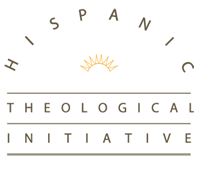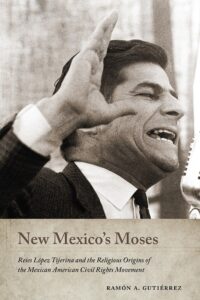Ramón A. Gutiérrez presents the life of the controversial Pentecostal preacher and activist Reies López Tijerina, in New Mexico’s Moses by inviting the reader into Tijerina’s “mental universe” (225). By interweaving sermons, interviews, and testimonies from family members, the author delves deeply into Tijerina’s life before and after his fight to return land grants to the Hispanos of New Mexico in the 1960s which often overshadows Tijerina’s complex life. Gutiérrez covers the life and context of Tijerina chronologically through an engaging yet clear story-like account. Gutiérrez aims to narrate Tijerina’s religious formation and how it morphed his famed land grant activism and the broader history of Mexican-American civil rights movements (10).
Gutiérrez’s interests were sparked by the collection of Tijerina’s sermons, ¿Hallará Fe en La Tierra?, conveniently located and translated in the index which exemplified Tijerina’s anti-materialism, morality, and religiosity (15). Chapter one recounts the socio-ethnic and economic origins of the Tijerina family and chapter two concerns the rise of Pentecostalism. The subsequent chapter follows closely his journey from an education at the Latin American Bible Institute where he was doused in Pentecostal doctrine and experienced the despondencies of White supremacy to his ministry in chapter four (67). Gutiérrez highlights the grandiose and extreme aestheticism displayed by the Pentecostal preacher when he burrowed into a hill and entered “delirium” (81). Gutiérrez, however, does not allow the strife of María, his first wife, and kids to be silenced. Tijerina would flippantly travel across the country and leave them to “back-breaking farm work” to go unnoticed (94).
Due to the deep connection, Tijerina had with the book of Revelation—which heavily influenced his preaching, theology, and sense of justice—Gutiérrez offers some general historical and thematic aspects of the book in the fifth chapter before moving on to its influence on Tijerina’s hermeneutic of life. Tijerina, as Gutiérrez notes, emphasized a patriarchal household and a legalistic God that condemned the materialist sensibilities of America (87, 113). Tijerina was known for preaching against the Church and loathed big-name evangelists like Billy Graham. Still, he rarely lived up to his standards for familial structures, Church, and American society (121, 125). Filled with the possibility of a nuclear apocalypse and a desire to escape capitalist modern society, Tijerina led a community into the Arizona desert described in chapter seven (131). Here Gutiérrez thoroughly describes the construction of homes and schools while narrating the community’s slow declension while waiting for Christ’s return (133). Finally, the remaining chapters focus on the attempted restoration of the land grants stolen from the Hispanos of northern New Mexico. Positioning himself as “Moses leading the oppressed Israelites to the promised land” Tijerina was invigorated to bring justice to the people of God (151).
While reading, one will surely notice Gutiérrez’s prominent authorial voice concerning the controversial figure’s life and retellings. Often, Gutiérrez catches the preacher in lies about his perverse sexual behavior, school records, and past accounts exposing the tendency to idolize the most prominent of our Civil Rights Movements. By positioning Tijerina in light of his religious and socio-economic origins the veil of grandeur and prophetic proclamations slowly pulls back to reveal a troubled man.
Though Tijerina suffered from schizophrenia and bipolar disorder, he suffered the injustices of America as well. After formulating a coalition with other activists like Elijah Muhammad and Tomas Banyacya, he and his family became a target of surveillance (176-179). Yet, Tijerina ought to be criticized for his misogyny, incest, and antisemitic rhetoric by demythologizing this preacher. Gutiérrez subversively uses the testimonies of his family, craftily engaging Tijerina’s autobiography “They Called Me “King Tiger”: My Struggle for the Land and Our Rights on its own terms while referring to oral histories and other documents as fact-checkers. In the end, this reveals a man concerned about his audience more than his family’s well-being (232).
Intriguingly, Gutiérrez is candid about his relationship with Tijerina noting their time spent in the library and private discussions. Gutiérrez’s deep commitment to this story and its subject amplifies the intimacy of the text, drawing a sense of closeness to the story at hand. Often, we view our “heroes” as valientes (brave) but increasingly, as the author notes, further studies revealed moral lapses and the patriarchal nature prominently found in figures like César Chávez and Tijerina (232). New Mexico’s Moses offers a sobering awakening to how religion and mental health influenced the Mexican American Civil Rights Movement. Ramón A. Gutiérrez thus should be held in high regard with this complex and humanizing narrative of Moses, El Tigre, Reies López Tijerina.
________________________________________________________________
[Traducción en español]
Ramón A. Gutiérrez presenta la vida del controversial predicador pentecostal y activista Reies López Tijerina, in New Mexico’s Moses (El Moisés de Nuevo México) al invitar al lector al “universo mental” de Tijerina (225). Al entretejer sermones, entrevistas y testimonios de familiares, el autor entra de lleno en la vida de Tijerina antes y después de su lucha para devolver concesiones de tierras a los hispanos de Nuevo México en la década de los años 60, lo que muchas veces eclipsa la compleja vida de Tijerina. Gutiérrez cubre la vida y el contexto de Tijerina cronológicamente por medio de un atractivo pero claro relato tipo historieta. Gutiérrez pretende narrar la formación religiosa de Tijerina y cómo esta transformó su famoso activismo de concesiones de tierras y la más amplia historia del movimiento de los derechos civiles mexicoamericanos (10).
El interés de Gutiérrez surge con la colección de los sermones de Tijerina, ¿Hallará fe en la Tierra?, convenientemente localizados y traducidos en el índice lo cual ejemplifica el anti-materialismo, la moralidad y la religiosidad de Tijerina (15). El capítulo uno narra los orígenes socio-étnicos y económicos de la familia Tijerina y el capítulo dos tiene que ver con el surgimiento del pentecostalismo. Los siguientes capítulos siguen muy de cerca su trayectoria de una educación en el Instituto Bíblico Latinoamericano donde se empapó en la doctrina pentecostal y donde experimentó los desalientos de la supremacía blanca hasta su ministerio en el capítulo cuatro (67). Gutiérrez recalca el esteticismo grandioso y extremo que el predicador pentecostal exhibe al enterrarse en un cerro adentrándose en el “delirio” (81). Gutiérrez, no obstante, no impidió la lucha de María, su primera esposa, y sus hijos fuera silenciada. Tijerina viajaba frívolamente a lo largo del país y abandonándolos a la ardua labor del trabajo en la granja para pasar desapercibido (94).
Debido a su profunda conexión que Tijerina tenía con el libro del Apocalipsis, el cual influyó mucho en su prédica, su teología y su sentido de justicia, Gutiérrez ofrece unos aspectos históricos generales y temáticos de su libro en el quinto capítulo antes de pasar a su influencia en la hermenéutica de vida de Tijerina. Como apunta Gutiérrez, Tijerina enfatizó una familia patriarcal y un Dios legalista que condenaba las sensibilidades materialistas de los Estados Unidos (87, 113). Tijerina era reconocido por predicar en contra de la Iglesia y odiaba los evangelistas de renombre como Billy Graham. Aun así, él raramente estuvo a la altura de sus estándares en cuanto a estructuras familiares, Iglesia y sociedad estadounidense (121, 125). Al filo de la posibilidad de un apocalipsis nuclear y a un deseo de escapar de la sociedad capitalista moderna, Tijerina dirigió una comunidad al desierto de Arizona descrito en el capítulo siete (131). Aquí Gutiérrez minuciosamente describe la construcción de viviendas y escuelas mientras narra la lenta decadencia de la comunidad mientras esperaban el regreso de Cristo (133). Finalmente, los capítulos restantes se centran en el intento de restauración de las concesiones de tierras robadas a los hispanos del norte de Nuevo México. Ubicándose como Moisés al guiar a los israelitas oprimidos a la tierra prometida”, Tijerina se robusteció para llevar justicia al pueblo de Dios (151).
Al leer, uno seguramente se dará cuenta de la voz autoral de Gutiérrez referente a la vida de la controvertida figura y los recuentos. A menudo, Gutiérrez descubre al predicador mintiendo sobre su perverso comportamiento sexual, sus registros escolares y recuentos pasados que exponen la tendencia a idolatrar los más prominente de nuestros movimientos por los derechos civiles. Al posicionar a Tijerina a la luz de sus orígenes socioeconómicos y religiosos, el velo de grandeza y proclamaciones proféticas lentamente cae revelando un hombre problemático.
Aunque Tijerina padecía de esquizofrenia y trastorno bipolar, a la vez sufrió de las injusticias de los Estados Unidos. Después de crear una coalición con otros activistas como Elijah Muhammad y Tomás Banyacya, su familia y él se convirtieron en blanco de la vigilancia (176-179). Sin embargo, Tijerina debe ser criticado por su misoginia, incesto y retórica antisemita al desmitificar a este predicador. Gutiérrez subversivamente utiliza los testimonios de sus familiares, empleando astutamente la autobiografía de Tijerina They Called Me King Tiger: My Struggle for the Land and Our Rights (Me llamaban “Rey Tigre”: Mi lucha por la tierra y nuestros derechos) en sus propios términos mientras que hace referencia a sus relatos orales y otros documentos como verificadores de hechos. Al final, esto revela un hombre preocupado por su audiencia más que por el bienestar de su familia (232).
Curiosamente, Gutiérrez es sincero en cuanto a su relación con Tijerina al notar el tiempo que pasó en la biblioteca y platicando privadamente. El compromiso serio de Gutiérrez a esta historia y su sujeto amplifica la intimidad del texto al generar un sentido de cercanía con el presente relato. A menudo imaginamos a nuestros “héroes” como valientes, pero cada vez más, como nota el autor, estudios posteriores revelan lapsos morales en la naturaleza patriarcal encontrada prominentemente en figuras de la talla de César Chávez y Tijerina (232). El New Mexico’s Moses (El Moisés de Nuevo México) ofrece un despertar instructivo sobre cómo la religión y la salud mental influyeron en el movimiento de derechos civiles mexicoamericanos. Ramón A. Gutiérrez debe pues ser muy apreciado con esta narrativa compleja y humanizadora de Moisés, El Tigre, Reies López Tijerina
[Traducido por Francisco Castillo, Loyola University New Orleans]Princeton Theological Seminary




